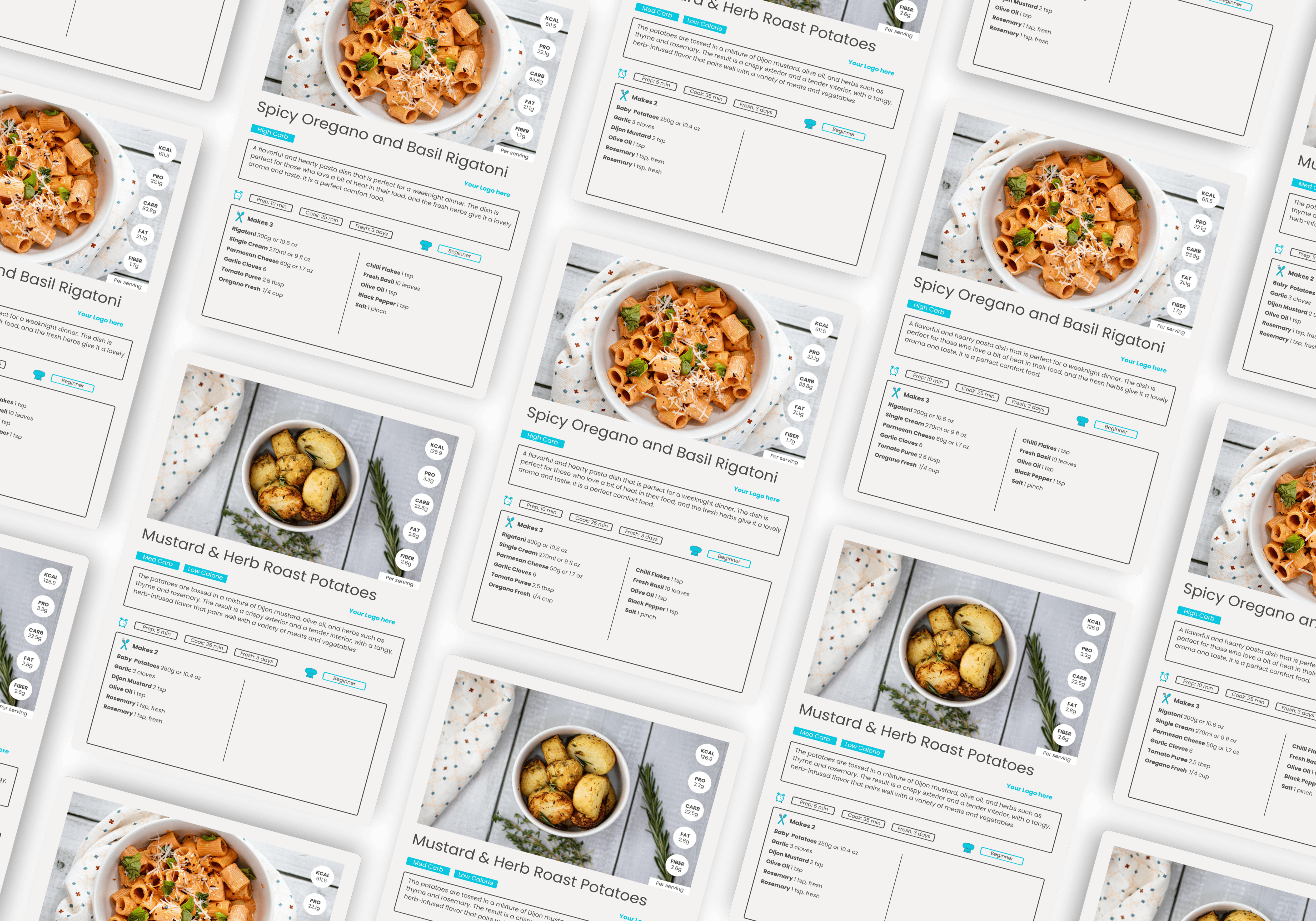Optimizing Carbohydrate Intake for Peak Athletic Performance
As a nutrition coach or fitness professional, you understand the critical role carbohydrates play in fueling your clients’ athletic performance, immune health, and body composition. Managing carbohydrate intake can be a complex task, but it’s essential to ensure that your clients have the energy they need to reach their peak potential. That’s where Carb Codes come in. These intuitive, color-coded indicators simplify the process of optimizing carbohydrate intake for athletes based on individual needs and training demands.
Carb Codes, integrated into The Content Cook’s customizable recipe cards, provide an easy-to-follow traffic light system that categorizes meals according to their carbohydrate content. This system allows you and your clients to easily adjust energy intakes based on exercise intensity, duration, and personal goals. In this blog post, we will explore the science behind Carb Codes, their implementation in the traffic light system, and the benefits they offer to your clients. By understanding and utilizing this powerful tool, you can elevate your coaching services and help your clients achieve their desired results.

Carbohydrates: A Crucial Energy Source for Athletes
Carbohydrates are a fundamental energy source for athletes, particularly during high-intensity exercises and prolonged aerobic activities. They are stored in the body as glycogen, primarily in the muscles (approximately 400 grams) and the liver (around 80-100 grams). The total storage capacity may seem substantial at first, but compared to fat stores, carbohydrates are limited.
Fat is a more energy-dense fuel source, providing 9 calories per gram, whereas carbohydrates yield only 4 calories per gram. For example, an 80 kg male with 15% body fat has 12,000 grams of fat (12 kg) or 108,000 calories, dwarfing the 2,000 calories of carbohydrate storage. This highlights the importance of tailoring carbohydrate intake to match an athlete’s energy requirements for both exercise and recovery.
Research has shown that our glycogen stores deplete following exercise, and consuming a high-carbohydrate diet can restore these levels to baseline or close to baseline. Pre-exercise carbohydrate intake has been found to increase time to fatigue, further emphasizing the significance of carbohydrates in athletic performance.
In summary, carbohydrates are essential for maintaining high levels of performance in athletes. The key lies in understanding how to manage carbohydrate intake effectively to support an individual’s energy demands and recovery needs.
Carb Codes: A Simplified Approach to Carbohydrate Management
Carb Codes, featured on The Content Cook’s recipe cards, offer a streamlined solution for managing carbohydrate intake. They utilize a traffic light system to categorize meals based on their carbohydrate content: green for high-carb, orange for moderate-carb, and red for low-carb. By assigning a color code to each meal, you can quickly and easily adjust your clients’ carbohydrate consumption according to their training needs and goals.
Green Meals (60+ grams of carbs): Ideal for training days or sessions with high carbohydrate demands, green meals provide ample energy for intense or prolonged exercise. These meals should be consumed on high-demand days or surrounding high-demand sessions to ensure adequate energy and support recovery.
Orange Meals (30-60 grams of carbs): Suited for moderate-demand training days or sessions, orange meals supply a lower yet sufficient amount of carbohydrates to fuel moderate-intensity workouts and facilitate recovery.
Red Meals (<30 grams of carbs): Recommended for rest days or low-intensity exercise, red meals contain minimal carbohydrates. Consuming red meals can potentially improve fat oxidation rates and contribute to certain physiological adaptations. However, caution should be exercised when following a low-carbohydrate diet for extended periods or during high-intensity training.
The Carb Codes system helps nutrition professionals individualize their clients’ carbohydrate intake based on exercise intensity, duration, and overall goals. By leveraging this practical tool, you can support your clients in achieving optimal performance and desired outcomes.
Carbohydrate Availability and its Impact on Performance
Carbohydrate availability refers to the amount of readily available carbohydrate for use during physical activities. It is a crucial factor for athletes, as carbohydrates serve as the primary fuel source during high-intensity and prolonged aerobic exercise. Having adequate carbohydrate availability is essential to support optimal athletic performance and to prevent premature fatigue.
When an athlete’s carbohydrate availability is low, their body relies more on fat stores for energy, which is less efficient, especially during high-intensity activities. This can lead to reduced exercise capacity, increased fatigue, and impaired decision-making. Additionally, low carbohydrate availability can hinder recovery and increase the risk of illness and injury.
To enhance carbohydrate availability, athletes can:
- Follow a diet that contains adequate carbohydrates to support their training needs. This will help increase glycogen storage capacity in the muscles and liver.
- Consume a carbohydrate-rich meal before exercise. This approach favors carbohydrate oxidation during exercise and helps maintain blood glucose levels.
- Use exogenous carbohydrate sources, such as energy gels or sports drinks, during activities lasting more than 60 minutes. This strategy helps maintain blood glucose levels and supports prolonged endurance performance.
Traffic Light System: Green, Orange, and Red
The traffic light system is a practical and straightforward approach to managing an athlete’s diet based on their carbohydrate needs. It helps athletes easily adjust their carbohydrate intake according to their training demands, thus ensuring optimal performance, immune health, and desired body composition.
- Green days/high meals: These are high-demand days or meals, where athletes require a high amount of carbohydrates to fuel their workouts and support recovery. Green meals contain 60+ grams of carbs.
- Orange days/medium meals: These are moderate-demand days or meals, with lower but still adequate amounts of carbohydrates to meet the energy requirements and facilitate recovery. Orange meals contain 30-60 grams of carbs.
- Red days/low meals: These are low-demand days or meals, such as rest days or light regenerative exercise sessions. Red meals have low carbohydrate content (<30 grams), which may improve fat oxidation rates and related physiological adaptations.
The traffic light system categorizes meals based on their carbohydrate content, enabling athletes to tailor their carbohydrate intake to their daily energy needs. Green meals are rich in carbohydrates (60+ grams), suitable for high-demand days or sessions. Orange meals contain moderate amounts of carbohydrates (30-60 grams), appropriate for moderate-demand days or sessions. Red meals have low carbohydrate content (<30 grams), ideal for low-demand days or rest days. This flexible system allows athletes to adapt their diet according to their training cycles and performance goals.
Nutritional Periodization and Carb Codes
Nutritional periodization refers to the strategic manipulation of an athlete’s diet to align with their training cycles and performance goals. It involves adjusting the macronutrient composition, meal timing, and overall calorie intake to support various phases of training, such as endurance, strength, or recovery.
Carb Codes provide a simple and effective way to implement nutritional periodization for athletes. By categorizing meals based on their carbohydrate content, athletes can quickly adapt their carbohydrate intake to match their energy needs during different training phases. This helps ensure that they consume the right amount of carbohydrates to fuel their workouts, recover properly, and achieve their performance and body composition goals.
To optimize their nutritional periodization strategy, athletes can adjust Carb Codes based on their training cycles and performance objectives. For example, during a high-intensity training phase, an athlete might prioritize green meals to ensure adequate carbohydrate intake. Conversely, during a recovery phase or when aiming to improve fat oxidation rates, an athlete might opt for more red meals. By tailoring Carb Codes to their specific needs, athletes can effectively support their performance, immune health, and desired body composition.
Benefits of Carb Codes for Nutrition Clients
Carb Codes offer a straightforward approach to diet management for athletes, making it easier for them to align their carbohydrate intake with their training and performance goals. By categorizing meals based on carbohydrate content, athletes can quickly adjust their diets to meet the demands of their workouts without the need for complex calculations or tracking.
Carb Codes help athletes optimize their carbohydrate intake to support various aspects of their health and performance. Ensuring adequate carbohydrate availability is crucial for maintaining high levels of performance, promoting immune health, and achieving the desired body composition. Carb Codes enable athletes to make informed decisions about their diets, which can lead to improved overall results.
By using Carb Codes, athletes can easily adapt their energy intake according to their training schedules and rest days. This allows them to consume the appropriate amount of carbohydrates to fuel their workouts and support recovery while avoiding excessive calorie intake on rest days. This flexibility helps athletes maintain a balanced diet that supports their training and performance goals.
Carb Codes on The Content Cook's Recipe Cards
The Content Cook’s customizable recipe cards integrate Carb Codes, providing a clear and simple way for nutrition professionals to communicate dietary recommendations to their clients. The inclusion of these codes makes it easy for clients to understand and follow their personalized nutrition plans, ensuring they consume the right amount of carbohydrates based on their training and performance needs.
Nutrition professionals can use Carb Codes to develop tailored meal plans for their clients, allowing them to address the unique needs of each individual. By taking into account factors such as training intensity, duration, and goals, nutritionists can create customized meal plans featuring the appropriate Carb Codes. This enables clients to achieve their desired results while maintaining a balanced and healthy diet.
The Content Cook offers both subscription-based and one-off bundles, providing nutrition professionals with the flexibility to choose the option that best suits their clients’ needs. With a monthly subscription, clients receive a new set of 12 recipe cards each month, ensuring variety and ongoing support. For those who prefer a less committed approach, one-off bundles are available, providing an excellent starting point for implementing Carb Codes into their meal plans.
Conclusion
Carb Codes serve as an effective tool for managing athletes’ diets, helping them optimize their performance, immune health, and body composition. By categorizing meals based on their carbohydrate content and aligning them with training demands, Carb Codes simplify the process of balancing energy intake and expenditure.
Nutrition professionals should consider exploring The Content Cook’s customizable recipe cards featuring Carb Codes. These cards offer a straightforward approach to personalizing clients’ meal plans, ensuring they consume the right amount of carbohydrates based on their specific needs and goals.
Incorporating Carb Codes into clients’ meal plans has the potential to significantly improve their performance and overall health. By tailoring carbohydrate intake to match the demands of their training and recovery, clients can optimize their energy levels, support their immune system, and achieve their desired body composition. The Content Cook’s recipe cards make implementing Carb Codes both easy and effective, providing a valuable resource for nutrition professionals and their clients.



